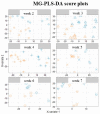Breast Milk Lipidome Is Associated with Early Growth Trajectory in Preterm Infants
- PMID: 29385065
- PMCID: PMC5852740
- DOI: 10.3390/nu10020164
Breast Milk Lipidome Is Associated with Early Growth Trajectory in Preterm Infants
Abstract
Human milk is recommended for feeding preterm infants. The current pilot study aims to determine whether breast-milk lipidome had any impact on the early growth-pattern of preterm infants fed their own mother's milk. A prospective-monocentric-observational birth-cohort was established, enrolling 138 preterm infants, who received their own mother's breast-milk throughout hospital stay. All infants were ranked according to the change in weight Z-score between birth and hospital discharge. Then, we selected infants who experienced "slower" (n = 15, -1.54 ± 0.42 Z-score) or "faster" (n = 11, -0.48 ± 0.19 Z-score) growth; as expected, although groups did not differ regarding gestational age, birth weight Z-score was lower in the "faster-growth" group (0.56 ± 0.72 vs. -1.59 ± 0.96). Liquid chromatography-mass spectrometry lipidomic signatures combined with multivariate analyses made it possible to identify breast-milk lipid species that allowed clear-cut discrimination between groups. Validation of the selected biomarkers was performed using multidimensional statistical, false-discovery-rate and ROC (Receiver Operating Characteristic) tools. Breast-milk associated with faster growth contained more medium-chain saturated fatty acid and sphingomyelin, dihomo-γ-linolenic acid (DGLA)-containing phosphethanolamine, and less oleic acid-containing triglyceride and DGLA-oxylipin. The ability of such biomarkers to predict early-growth was validated in presence of confounding clinical factors but remains to be ascertained in larger cohort studies.
Keywords: breast milk lipidome; growth trajectory; preterm infant.
Conflict of interest statement
No funder/sponsor had any role in the design and conduct of the study; collection, management, analysis, and interpretation of the data; the preparation, review, or approval of the manuscript; or the decision to submit the manuscript for publication.
Figures





Similar articles
-
Comprehensive Preterm Breast Milk Metabotype Associated with Optimal Infant Early Growth Pattern.Nutrients. 2019 Feb 28;11(3):528. doi: 10.3390/nu11030528. Nutrients. 2019. PMID: 30823457 Free PMC article.
-
Comparison of different protein concentrations of human milk fortifier for promoting growth and neurological development in preterm infants.Cochrane Database Syst Rev. 2020 Nov 20;11(11):CD007090. doi: 10.1002/14651858.CD007090.pub2. Cochrane Database Syst Rev. 2020. PMID: 33215474 Free PMC article.
-
Differences in growth patterns and catch-up growth of small for gestational age preterm infants fed on fortified mother's own milk v. preterm formula.Br J Nutr. 2023 Jun 28;129(12):2046-2053. doi: 10.1017/S0007114522000599. Epub 2022 Jun 24. Br J Nutr. 2023. PMID: 35748057 Free PMC article.
-
Nutrition, growth, and allergic diseases among very preterm infants after hospital discharge.Dan Med J. 2013 Feb;60(2):B4588. Dan Med J. 2013. PMID: 23461996 Review.
-
Growth Benefits of Own Mother's Milk in Preterm Infants Fed Daily Individualized Fortified Human Milk.Nutrients. 2019 Apr 3;11(4):772. doi: 10.3390/nu11040772. Nutrients. 2019. PMID: 30987136 Free PMC article.
Cited by
-
Human Milk Lipidomics: Current Techniques and Methodologies.Nutrients. 2018 Aug 26;10(9):1169. doi: 10.3390/nu10091169. Nutrients. 2018. PMID: 30149663 Free PMC article. Review.
-
Comprehensive Preterm Breast Milk Metabotype Associated with Optimal Infant Early Growth Pattern.Nutrients. 2019 Feb 28;11(3):528. doi: 10.3390/nu11030528. Nutrients. 2019. PMID: 30823457 Free PMC article.
-
Human Milk: An Ideal Food for Nutrition of Preterm Newborn.Front Pediatr. 2018 Oct 16;6:295. doi: 10.3389/fped.2018.00295. eCollection 2018. Front Pediatr. 2018. PMID: 30386758 Free PMC article. Review.
-
Regulation of plasmalogen metabolism and traffic in mammals: The fog begins to lift.Front Cell Dev Biol. 2022 Aug 31;10:946393. doi: 10.3389/fcell.2022.946393. eCollection 2022. Front Cell Dev Biol. 2022. PMID: 36120579 Free PMC article. Review.
-
miR-370-3p Regulates Adipogenesis through Targeting Mknk1.Molecules. 2021 Nov 17;26(22):6926. doi: 10.3390/molecules26226926. Molecules. 2021. PMID: 34834018 Free PMC article.
References
-
- World Health Organization. United Nations Children’s Fund . Global Strategy for Infant and Young Child Feeding. 1st ed. World Health Organization; Geneva, Switzerland: 2003. p. 30.
-
- American Academy of Pediatrics Section on Breastfeeding. Breastfeeding and the use of human milk. Pediatrics. 2012;129:e827–e841. - PubMed
Publication types
MeSH terms
Substances
LinkOut - more resources
Full Text Sources
Other Literature Sources
Medical

